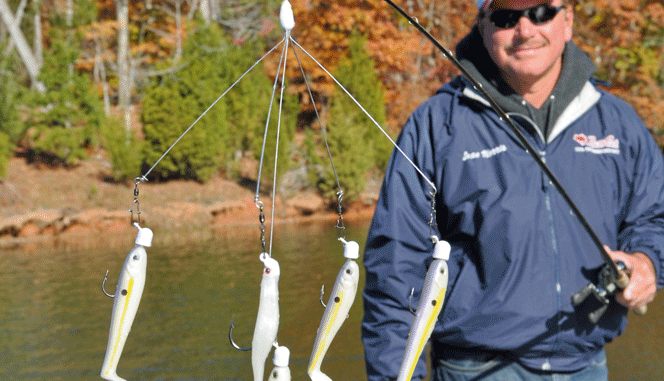
Spinoff of ‘umbrella rig’ is a hit with fishermen targeting largemouth bass
Since bass pro Paul Elias won a national bass tournament in Alabama a few months ago with a revolutionary freshwater fishing lure, the “Alabama rig” has attracted extreme attention from bass fishermen across the nation.
But as Ecclesiastes 1:9 says, there is no new thing under the sun, and the ’Bama rig proves that observation. Offshore fishermen and some striper fishermen will recognize the rig as an adaptation of the “Umbrella rig” that is an effective trolling tool.
In North Carolina, apparently the first group to succumb to the, well, uh, lure of the ’Bama rig was the BassPack, the competition fishing team from N.C. State University.
The college anglers often fish at Lake Gaston on the Virginia-North Carolina border, and recently, they’ve fished interclub events and astounded the scattered few other bass anglers remaining active during November on Gaston.
Five-fish limits in spring, the best time to land lunkers, normally total about 15 pounds at Gaston. But the BassPackers regularly see winners land 20-pound limits on the 20,300-acre impoundment.
Kevin Beverley won a tournament last Nov. 12, on the Roanoke River impoundment with 19.15 pounds, followed by Paul Owens with 16.15 pounds and Ben Dziwukski with 16.14 pounds.
“We have won $77,000,” Dziwukski said.
Ivan Morris, a long-time tournament fisherman from Virginia Beach who spends weekends at his home on Lake Gaston, where he and wife Janet are neighbors of Owens’ family. He borrowed an Alabama rig from Owens to fish the final event of the year for his Lake Gaston Bassholes club — with the club championship on the line.
“I’d never seen (a ’Bama rig) until the Paul let me use one,” said Morris, whose younger brother, Rick, is a BASS pro and former runnerup in the Bassmaster Classic. “Before the tournament, I didn’t have a pattern or lure that was working.”
Morris won the club championship with 13 pounds, 10 ounces, all caught with an Alabama rig in his first attempt at using it.
“I used a 7-foot-1.2-foot Rick Morris RPM x-rod with 15-pound braid on Shimano CH100 B5V baitcasters,” Morris said. “I don’t use a leader, but tie the (rig) to the braid with a Uni-knot.”
The Alabama rig has seven pieces of wire, with snap swivels attached to five of them — to attach to lures. Morris chose white, soft-plastic Shadilicious paddletail minnows with an EWG (extra wide gap) hook and a dark-colored jighead for his tournament. Other anglers pick other lures, which is one of the attractive features of the Alabama rig — the lure choices and combinations are infinite, and everyone has his own idea as to which.
“The way to fish Gaston right now with the Alabama rig is to cast it toward the shore and reel it back to you with enough speed to let the lure just tick the tops of the grass,” Morris said. “The key is, you have to develop a feel for (retrieving) because the grass drops away as your lure runs deeper, and the bass are biting at about 10 feet down. But if you reel too slowly, the lure’s hooks will get fouled by grass”
Like bailing dolphin, where a hooked fish is kept in the water to attract other mahi within casting range, fishermen using an Alabama rig often keep a small- to medium-size largemouth in the water and hope a bigger bass will attack one of the rig’s other lures.
“We’ve picked up a lot of 5-pounders that way,” Morris said. “A lot of times you’ll lose the smaller fish, but sometimes that’s not such a bad thing.”
Casting isn’t that difficult, probably because it doesn’t require a lot of finesse, just ability to hit a 6-foot diameter circle. The key is retrieve speed.
“You don’t have to worry much about setting a hook,” Morris said, “because bass slam this thing.”
The major challenge for the Alabama rig will be during tournaments where organizers already are questioning its legality, as most tournaments restrict fishermen to one lure at a time. However, bass pros have used topwater baits with “dropper” lures regularly, and the “Front Runner” has been a popular bait fished in front of a topwater plug for years.



Be the first to comment